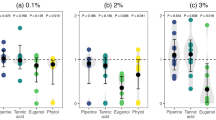Abstract.
Honey bees satisfy their lipid requirement by consuming pollen. The free fatty acid content of the midgut was used to quantify fat digestion. Midguts extracted from younger workers of known ages and from foragers were divided into three components: endoperitrophic region (peritrophic membrane with gut contents), extraperitrophic region and intestinal wall. Both the total amount of pollen and the amount of free fatty acids in the endoperitrophic region and in the intestinal wall depend on the bee's age. The amounts increase within the 1st 3 days of a honey bee's life, reach maxima around the age of 8 days and then decrease continuously to the lowest values, measured in forager bees. Forced feeding with triacylglycerol results in significantly higher levels of free fatty acids, especially in the endoperitrophic region, in 8-day-old bees and foragers. This indicates that lipolytic activity depends on age and that the free fatty acid content in 8-day-old bees is primarily limited by the amount and availability of lipids ingested. The results show further that fat digestion depends on the functional status of honey bees, as is the case for pollen consumption, speed of transport of pollen bolus through the alimentary canal and protein digestion.
Similar content being viewed by others
Author information
Authors and Affiliations
Additional information
Electronic Publication
Rights and permissions
About this article
Cite this article
Loidl, A., Crailsheim, K. Free fatty acids digested from pollen and triolein in the honeybee (Apis mellifera carnica Pollmann) midgut. J Comp Physiol B 171, 313–319 (2001). https://doi.org/10.1007/s003600100178
Accepted:
Issue Date:
DOI: https://doi.org/10.1007/s003600100178




